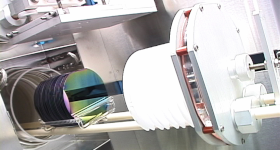SIPOS (Semi-Insulating Polycrystalline Silicon)
SIPOS (Semi-Insulating Polycrystalline Silicon) is a Low Pressure Chemical Vapor Deposition (LPCVD) process for the deposition of high resistivity polysilicon layers, which are primarily used in the fabrication of high voltage semiconductor devices. SIPOS films overcome the disadvantages of SiO2 films, such as accumulation of fixed ions and electric charges at the SiO2/Si interface, charge retention in the SiO2 layer, and the high mobility of alkali ions at elevated temperatures and high electric fields. These problems cause reduced breakdown and sustaining voltage levels of high voltage devices, device instabilities, and impaired reliability due to ion migration in the SiO2 layer. SIPOS films are primarily used as field plates in high voltage devices to extend the high electric field at the PN junction/ SiO2 interface over a larger distance.
The equipment used for the deposition of SIPOS films is standard semiconductor LPCVD equipment. It requires a vacuum-tight quartz tube heated uniformly to 620 to 680 °C, a vacuum pump and control system with a base pressure of 2 - 5 mTorr for continuous gas flow during the deposition process, and a gas control system for the supply of the reactant gases (SiH4 and N2O) and N2 for purging, pressure control and backfill. A suitable, programmable process controller is desirable to obtain repeatable and controlled results. Obtaining good thickness uniformity across the silicon wafers requires a special cage quartz wafer carrier similar to those used for LTO processes. The basic SIPOS process is very similar to other LPCVD processes. Controllable Process variables are:
- Typical Film Thickness: 0.45 µm
- Batch Size: 50
- Deposition Rate: 5 - 10 nm/min. (50 - 100 Å/min.)
- Deposition Gases: Dichlorosilane, Nitrous Oxide
- SiH4 flow. Higher flow rates give faster deposition rates.
- N2O flow rate: Ratio of SiH4 to N2O determines film resistivity. Higher N2O concentrations result in higher SIPOS resistivity. SIPOS film resistivities are between 100 to 1000 Ω cm.
- Temperature: Range from 620 to 680 °C. Higher temperature results in faster deposition rates, but at higher temperature films become poly-crystalline. Films deposited at lower temperatures are amorphous.
- Pressure: Deposition pressure can be controlled by flow rates of reactant gases or by the addition of N2. At higher reactant gas flows the deposition rates increase, with constant reactant gas flows and increased N2 dilution the film thickness uniformity improves in general.
Oxygen atomic concentration in SIPOS films can be varied from 0 to approximately 35%. Oxygen concentration uniformity is typically ± 1.5 At.%. SIPOS film resistivity is a function of the N2O/SiH4 ratio.
Applications: high voltage semiconductor devices, emitters, solar photovoltaic cells, anti-reflection coatings.
LPCVD Processes
- Silicon Carbide Devices
- Silicon Nitride Resonators
- Doped Silicon by LPCVD
- POLYSILICON LPCVD WITH SILANE (SiH4)
- POLYSILICON LPCVD WITH DISILANE (Si2H6)
- LTO, DOPED LTO, BPSG, BSG, AND PSG LPCVD
- HTO LPCVD
- TEOS LPCVD
- Silicon Nitride LPCVD
- Low-Stress Silicon Nitride LPCVD
- Stochiometric Silicon Nitride LPCVD
- Silicon Oxynitride (SiNxOy) LPCVD
- Silicon Germanium (Si-Ge) LPCVD
- SIPOS (Semi-Insulating Polycrystalline Silicon)
- Polycrystalline Silicon Carbide
- Epitaxial Silicon
- Nano Materials LPCVD



